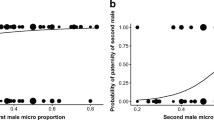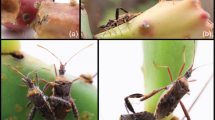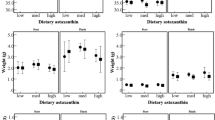Abstract
Male tree crickets, Oecanthus nigricornis, offer a nuptial gift to females during mating in the form of a secretion from a dorsal metanotal gland. I examined the effects of male and female nutrient limitation on allocation of the gift. Males were fed 14C radiolabeled amino acids, placed onto high- or low-quality diets and then mated with females also maintained on high- or low-quality diets. Female acquisition of radiolabel increased, and residual radiolabel within the metanotal gland decreased, over time verifying that gift size correlates with duration of courtship feeding. High-diet females produced greater egg numbers and allocated proportionally more of the male-derived amino acids to their ovaries. As predicted, duration of courtship feeding was greater for males on high-quality diets and females on low-quality diets. Amino acid transfer, measured as the proportion of total radiolabel transferred to the female, showed a significant interaction between male and female diet. High-diet females acquired available radiolabel more rapidly from high-diet males, but low-diet females acquired available radiolabel more rapidly from low-diet males. The causes of these differences between feeding duration and nutrient allocation are discussed.




Similar content being viewed by others
References
Arnqvist G, Nilsson T (2000) The evolution of polyandry: multiple mating and female fitness in insects. Anim Behav 60:145–164
Boggs CL (1995) Male nuptial gifts: phenotypic consequences and evolutionary implications. In: Leather SR, Hardie J (eds) Insect reproduction. CRC, New York, pp 215–242
Brown WD (1997a) Courtship feeding in the tree crickets increases insemination and female reproductive life span. Anim Behav 54:1369–1382
Brown WD (1997b) Female remating and the intensity of female choice in black-horned tree crickets, Oecanthus nigricornis. Behav Ecol 8:66–74
Brown WD (1999) Mate choice in tree crickets and their kin. Annu Rev Entomol 44:371–396
Brown WD (2008) Size-biased mating in both sexes of the black-horned tree cricket, Oecanthus nigricornis Walker (Orthoptera: Gryllidae: Oecanthinae). J Insect Behav 21:130–142
Brown WD, Gwynne DT (1997) Mating in crickets, katydids, and wetas. In: Gangwere SK, Muralirangan MC (eds) The bionomics of grasshoppers, katydids, and their kin. CAB International, Wallingford, UK, pp 281–314
Brown WD, Kuns MM (2000) Female choice and the consistency of courtship feeding in black-horned tree crickets. Ethology 106:543–558
Brown WD, Wideman J, Andrade MCB, Mason AC, Gwynne DT (1996) Female choice for an indicator of male size in the song of the black-horned tree cricket Oecanthus nigricornis (Orthoptera: Gryllidae: Oecanthinae). Evolution 50:2400–2411
Bussière L, Basit HA, Gwynne DT (2005a) Preferred males are not always good providers: female choice and male investment in tree crickets. Behav Ecol 16:223–231
Bussière L, Clark AP, Gwynne DT (2005b) Precopulatory choice for cues of material benefits in tree crickets. Behav Ecol 16:255–259
Dussourd DE, Harvis CA, Meinwald J, Eisner T (1989) Paternal allocation of sequestered plant pyrrolizidine alkaloid to eggs in the danaine butterfly, Danaus gilippus. Experientia 45:896–898
Dussourd DE, Harvis CA, Meiwald J, Eisner T (1991) Pheromonal advertisement of a nuptial gift by a male moth (Utetheisa ornatrix). Proc Natl Acad Sci USA 88:9224–9227
Fedorka KM, Mousseau TA (2002a) Nuptial gifts and the evolution of male body size. Evolution 56:590–596
Fedorka KM, Mousseau TA (2002b) Tibial spur feeding in ground crickets: larger males contribute larger gifts (Orthoptera: Gryllidae). Fla Entomol 85:317–323
Fedorka KM, Mousseau TA (2002c) Material and genetic benefits of female multiple mating and polyandry. Anim Behav 64:361–367
Friedel T, Gillott C (1977) Contribution of male-produced proteins to vitellogenesis in Melanoplus sanguinipes. J Insect Physiol 23:145–149
Gwynne DT (1990) Testing parental investment and the control of sexual selection in katydids: the operational sex ratio. Am Nat 136:474–484
Gwynne DT (2008) Sexual conflict over nuptial gifts in insects. Annu Rev Entomol 53:83–101
Gwynne DT, Brown WD (1994) Mate feeding, offspring investment, and sexual differences in katydids (Orthoptera: Tettigoniidae). Behav Ecol 5:267–272
Hall MD, Bussière LF, Brooks R (2008) The effect of diet quality and wing morph on male and female productive investment in a nuptial feeding ground cricket. PLoS ONE 3:1–8
Holzer B, Jacot A, Brinkhof MWG (2003) Condition-dependent signaling affects male sexual attractiveness in field crickets, Gryllus campestris. Behav Ecol 14:353–359
Hunt J, Brooks R, Jennions MD, Smith MJ, Bentsen CL (2004) High-quality male field crickets invest in sexual display but die young. Nature 432:1024–1027
Judge KA, Ting JJ, Gwynne DT (2008) Condition dependence of male lifespan and calling effort in a field cricket. Evolution 62:868–878
Larsdotter Mellström H, Wiklund C (2009) Males use sex pheromone assessment to tailor ejaculates to risk of sperm competition in a butterfly. Behav Ecol 20:1147–1151
Lederhouse RC, Ayres MP, Scriber JM (1990) Adult nutrition affects male virility in Papilio glaucus L. Funct Ecol 4:743–751
Lewis SM, Cratsley CK (2008) Flash signaling, mate choice, and predation in fireflies. Annu Rev Entomol 53:293–321
Mullins DE, Keil CB (1980) Paternal investment of urates in cockroaches. Nature 283:567–569
Sakaluk SK, Avery RL, Weddle CB (2006) Cryptic sexual conflict in gift-giving insects: chasing the chase-away. Am Nat 167:94–104
Simmons LW (1993) Some constraints on reproduction for male bushcrickets, Requena verticalis (Orthoptera: Tettigoniidae): diet, size and parasite load. Behav Ecol Sociobiol 32:135–139
Simmons LW, Gwynne DT (1993) Reproductive investment in bushcrickets: the allocation of male and female nutrients to offspring. Proc R Soc Lond B 252:1–5
Simmons LW, Craig M, Llorens T, Schinzig M, Hosken D (1993) Bushcricket spermatophores vary in accord with sperm competition and parental investment theory. Proc R Soc Lond B 251:183–186
Vahed K (1998) The function of nuptial feeding in insects: a review of empirical studies. Biol Rev 73:43–78
Vahed K (2007) All that glitters is not gold: sensory bias, sexual conflict and nuptial feeding in insects and spiders. Ethology 113:105–127
Wedell N (1994) Variation in nuptial gift quality in bush-crickets (Orthoptera: Tettigoniidae). Behav Ecol 5:418–425
Acknowledgements
This work was supported by Syracuse University and a scholarly incentive award from SUNY Fredonia. I thank Ann Meany, Scott Pitnick, Andrew Sharman, and Wayne Yunghans for all their help.
Author information
Authors and Affiliations
Corresponding author
Additional information
Communicated by D. Gwynne
Rights and permissions
About this article
Cite this article
Brown, W.D. Allocation of nuptial gifts in tree crickets changes with both male and female diet. Behav Ecol Sociobiol 65, 1007–1014 (2011). https://doi.org/10.1007/s00265-010-1105-y
Received:
Revised:
Accepted:
Published:
Issue Date:
DOI: https://doi.org/10.1007/s00265-010-1105-y




